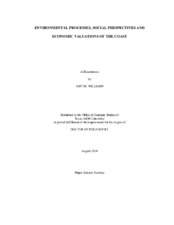| dc.description.abstract | Coastal ecosystems provide important resources for social, economic and environmental capital to global and local communities. Socially, coastal ecosystems provide a place for people to recreate and get in touch with nature. Economically, tourism, fisheries, and businesses are dependent upon coastal resources. Environmentally, coasts provide habitat for diverse species of flora and fauna, and protection for watersheds and anthropogenic structures.
This research investigates three studies in order to provide information on social, economic and environmental issues in Matagorda, Texas. The first study uses LIDAR (Light Image Detection-and-Ranging) scanning, a remote sensing methodology that uses laser pulses to collect X, Y, and Z coordinates, to evaluate coastal changes after Hurricane Ike. Results suggest that landscape loss occurs immediately after the hurricane, but recovers and fluctuates throughout the year. Also, different areas of the dunes show unique changes during different times of the year.
The second study uses questionnaire surveys to collect demographic, social perspectives and opinions and economic information about coastal users on Matagorda Peninsula. The questionnaire investigates the most important characteristics to beach users, opinions and perceptions about beach safety, activities, maintenance and presence of seaweed, information about their trip, cost of their trip and demographics. The results provide broader knowledge about the beach users in Matagorda and indicate that while direct costs of using the beach are minimal, the indirect and intrinsic costs are much higher which result in a greater overall use value.
The third study investigates the use of the sargassum, a natural marine subsidy, as a fertilizer for dune plants. Beach raking provides a cleaner, more aesthetically pleasing experience for beach users but alters the natural design of the ecosystem by subsequently moving sand, nutrients, subsidies for habitat and fauna from the fore-beach to the dunes. Results show that sargassum does have potential as a natural fertilizer as it did not negatively affect any of the species. The results could be used to alter management practices in order to capitalize on this natural resource while still providing a clean sandy beach for recreationalists.
These three studies together provide ecological information about coastal functions and processes that can help in creating broad holistic science based management strategies. | en |


